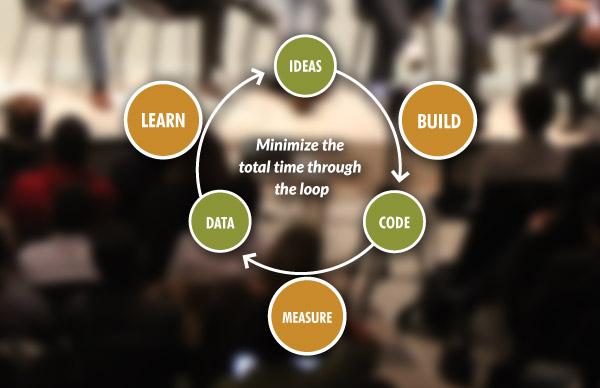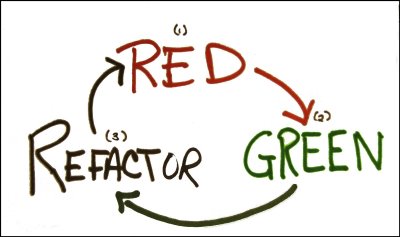Built-in Quality Practices
Lean Startup
Lean startup is a methodology for developing businesses and products that aims to shorten product development cycles and rapidly discover if a proposed business model is viable; this is achieved by adopting a combination of business-hypothesis-driven experimentation, iterative product releases, and validated learning.
Central to the lean startup methodology is the assumption that when startup companies invest their time into iteratively building products or services to meet the needs of early customers, the company can reduce market risks and sidestep the need for large amounts of initial project funding and expensive product launches and failures.
(source: http://theleanstartup.com/principles)
Principles
- Minimum Viable Product (MVP)
- Continuous Deployment (CD)
- Split Testing
- Actionable Metrics
- Pivot
- Innovation Accounting
- Build-Measure-Learn
Benefits
The top benefits of Lean Startup are:
- Closer to Customers
- Easier to pivot and react to market opportunities
- Enables going after smaller markets and opportunities
- Encourages quick and effective innovation
- Very low sales and marketing costs
Resources
Walking Skeleton
Alistair Cockburn defines the ‘Walking Skeleton’ as a tiny implementation of the system that performs a small end-to-end function. It need not use the final architecture, but it should link together the main architectural components. The architecture and the functionality can then evolve in parallel.
This approach helps developers identify all the big unknowns of a software and thus reducing the risks on large software development projects!
Practices
High Risk First
It is better to work on the riskiest parts of the project first since you don’t know how long it will take and what problems should arise. This helps shortening the feedback cycle.
No Shortcuts
The first acceptance test should be written only when the walking skeleton is deployed to production. Ideally, you want to detect any potential problems with your deployment and build scripts as soon as possible. This helps you validate the architecture and get feedback as early as possible.
By performing shortcuts, there will be a risk that such feedback is lost!
Benefits
Some benefits of the ‘Walking Skeleton’ are:
- Validate Assumptions
- Reality Check
- Reduces Risk
- Quicker Feedback
Resources
Test-Driven Development (TDD)
TDD is based on three rules, knows as ‘The Three Laws of TDD’:
- You must write a failing test before you write any production code.
- You must not write more of a test than is sufficient to fail, or fail to compile.
- You must not write more production code than is sufficient to make the currently failing test pass.
In code, TDD is translated into the cycle Red/Green/Refactor!
(source: https://blog.cleancoder.com/uncle-bob/2014/12/17/TheCyclesOfTDD.html)
The rules of this cycle are as follows:
- Create a unit tests that fails
- Write production code that makes that test pass.
- Clean up the mess you just made.
Benefits
The top 3 advantages of TDD are:
- Requires in-depth understanding of the what the code should do
- Increases the confidence in changing parts of the code
- Reduces the debugging time
Resources
Behavior-Driven Development (BDD)
BDD is the combination of practices from TDD, Domain Driven Design (DDD) and Object-Oriented Design to produce software-development collaboration tools and processes. Those tools and practices emphasizes that software development should be managed by business interest and technical insight.
Principles
Testing
In terms of testing, BDD is considered a continuation of TDD as it puts more focus on the desired behavior of the unit. The ‘Desired Behavior’ consists of the requirements defined by the business.
Behavioral Specifications
The second principle defines how the ‘desired behavior’ should be written. Here, BDD uses the terms ‘Scenario’ & ‘Specification’ to gather all requirements and expected outcome in a single place that is a User Story.
Although, there is no official format defined in BDD, there is a preference to follow the form ‘Given-When-Then’
Specification as a ubiquitous language
Ubiquitous Language is defined in DDD. It is a ‘semi-formal’ language that is developed and used by team-members to have common understanding of the discussion between them. Thus, reducing the risks of having a communication break-down between developers and stakeholders.
Benefits
The 3 benefits of BDD are:
- Guides and organizes the conversation between the different parties of the software development team (developers, testers and domain experts)
- The given-when-then canvas is closer to everyday language
- Tools targeting a BDD approach generally afford the automatic generation of technical and end user documentation from BDD “specifications”
Resources
Continuous Integration (CI)
Continuous Integration is a process that helps developers detect problems faster through frequent integration of code to a shared repository. The build, regression and acceptance tests are automated and executed at each check-in.
(source: http://www.pepgotesting.com/continuous-integration/)
Practices
- Maintain a single source repository
- Automate the build
- Make your build self-testing
- Every commit should build on an integration machine
- Keep the build fast
- Test in a clone of the production environment
- Make it easy for anyone to get the latest executable version
- Everyone can see what’s happening
- Automate deployment
Benefits
The 3 benefits of CI are:
- Generate deploy-able software at any time and at any place
- Shortens the feedback loop and reduces operational, technical & human risks
- Reduces the debugging time
Resources
CONTINUOUS INTEGRATION - ThoughtWorks
Dev Ops
DevOps is a set of practices that combines software development (Dev) and information-technology operations (Ops) which aims to shorten the systems development life cycle and provide continuous delivery with high software quality.
(source: https://guide.freecodecamp.org/devops/)
Practices
- Coding: Code Development and Review, Source Code Management tools, Code Merging
- Building: Continuous Integration Tools, Build Status
- Testing: Continuous Testing Tools
- Packaging: Artifact Repository, Application Pre-Deployment Staging
- Releasing: Change Management, Release Approvals, Release Automation
- Configuring: Infrastructure Configuration and Management, Infrastructure as Code Tools
- Monitoring: Applications Performance Monitoring, End-User Experience
Benefits
The 3 benefits of DevOps are:
- Faster releases and time to market
- Lower failure rate and downtime
- Shortened lead time between fixes
Resources
Craftsmanship
Software craftsmanship is an approach to software development that emphasizes the coding skills of the software developers. It is a response by software developers to the perceived ills of the mainstream software industry, including the prioritization of financial concerns over developer accountability.
Software craftsmanship came as a continuation for the Agile Framework. Agile focuses more individuals, how teams should collaborate, and how should the work be paced. But, it does not cover quality of the code or the design. Software craftsmanship was defined to cover those missing principles, as it ensures that a software should be both functional and well designed.
Manifesto
As aspiring Software Craftsmen we are raising the bar of professional software development by practicing it and helping others learn the craft. Through this work we have come to value:
- Not only working software, but also well-crafted software
- Not only responding to change, but also steadily adding value
- Not only individuals and interactions, but also a community of professionals
- Not only customer collaboration, but also productive partnerships
Serving Agility
Software Craftsmanship borrows practices from other agile methods: • Quality: simple design, DDD, OO, refactoring, TDD (XP) • Humility: questioning and continuous improvement (retrospectives) • Sharing: pair programming and collective ownership (XP) • Pragmatism: I understand the constraints and I adapt (Scrum) • Professionalism: I treat my client as a partner (XP)
Resources
Software craftsmanship - Wikipedia Manifesto for Software Craftsmanship How Software Craftsmanship Completes Agile Methods



